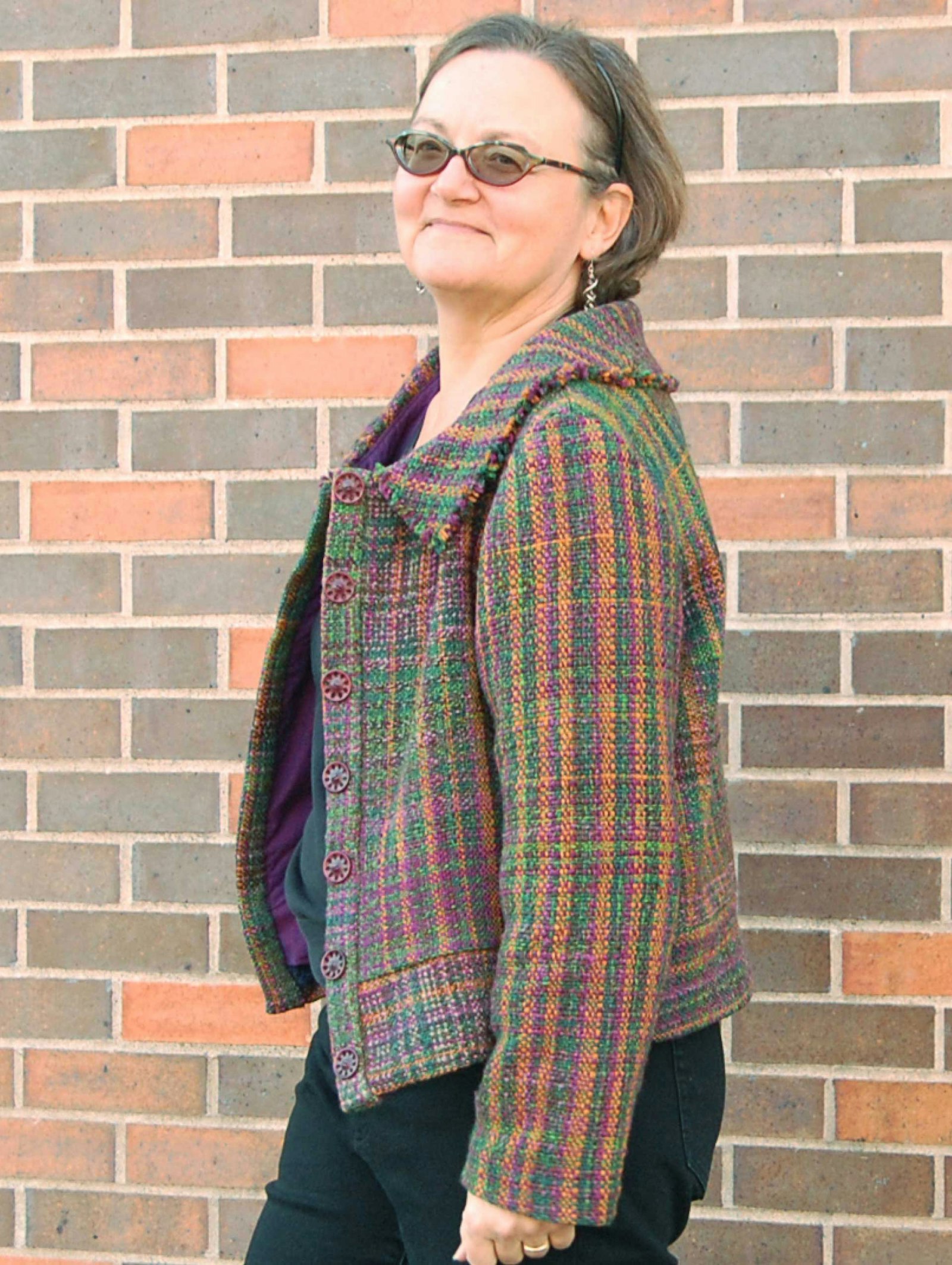After knitting for a number of years, I was curious about yarn construction. I took a class at a local yarn shop and became a spinner in 2000. Making yarn satisfies my desire to create useful objects that are aesthetically pleasing. I also love natural products. Spinning hits both of these buttons. I took up weaving in 2012 when my mother gifted me her loom and accessories.
Each year, I pick a project that pushes my skills a little further. After taking a beyond-basics spinning class from the Weavers Guild of Minnesota, I felt confident that I could tackle more significant projects. In 2019, I spun, wove, and sewed the front panel for a dress. To take things further, the project goal I set for 2020 was to make an entire garment. I wanted something multicolored so I would not get too bored with spinning a single color, and I wanted to make sure that the yarn could handle the reed and tension of a floor loom. I looked at various yarn structures and decided that a cabled yarn would be the most reliable for strength with four plies to even out any inconsistencies. My goals were to make a garment that could hold up to wear in a weave that would be looser than commercial fabric and to construct a garment without a lot of waste. I settled on a jacket.

Barbara’s handspun cabled yarn before weaving. She overdyed the yellow yarn with brown to tone down the color.
I had seen the pattern from Get Weaving and liked how it could be woven on a narrow loom to create a garment. It seemed like a good place to start. The seams of a jacket are less stressed than those on pants or skirts, making the jacket a suitable project for the looser weave I had in mind.
I decided to use Targhee for its ease of spinning and lovely bouncy hand. As I scrolled through the websites of my favorite dyers, I found the Mallard colorway from Greenwood Fiberworks and added the other colors to complement. I started spinning the singles, made a two-ply yarn, and then plied again for a cabled yarn. It was like magic when the cabled yarns came out of a finishing bath. They were beautiful.
Before I could set up my loom, I needed to establish the warping plan. Using a Schacht Zoom Loom, I created a sample to get a feel for the sett and color order. It was apparent right away that the yellow was too bright. After considering my options, I decided to use some brown dye to tone down the brightness. With some help from the internet, I weighed and dyed the yarn, and it turned out perfect. I wove a new sample and decided that the sett would be about 10 ends per inch (epi) and that I would need to place the colors randomly. Using a random number generator, I created a color sequence and measured the warp.
The weaving process was swift. With a plain-weave structure and easily tucked-in ends, I quickly wove the random sequence of the colors. When the fabric came off the loom, I was delighted. After a hot wet-finish, I laid the fabric out to dry. But then I could not get myself to cut it. It had to sit for a couple of weeks until I could think of it as fabric and not hours of spinning, plying, and weaving.

Barbara wove the fabric on a six-harness Loomcraft floor loom.
The jacket is warm, which works well in Minnesota winters. I love the colors, and they coordinate with many of my clothing options. I still have not added the buttonholes, although I sewed on the buttons. I am not confident the buttonholes will hold up without pulling the fabric apart. For now, the jacket is just fine without buttoning it up. This year, I’m planning to spin and weave a twill-structure wool skirt. And one of the talented hand-dyers will inspire me—I am sure of it!
Spinning Notes
Pattern and designer Get Weaving jacket pattern JA017 by Sarah Howard.
Fiber/preparation The fiber was dyed by three dyers: Greenwood Fiberworks, Targhee in a green color; Crafty Jak’s Boutique, Targhee in a yellow color; and Three Waters Farm, Finnsheep in a purple color. I used 20 ounces of Targhee and 8 ounces of Finnsheep. The yellow yarn turned out to be too bright when I wove a sample with the other yarns, so I used some Gaywool brown dye that I had on hand to tone down the color. It worked perfectly!
Wheel system SpinOlution Echo.
Drafting method Short-forward draw.
Singles direction S-spun.
Singles wraps per inch 24 wpi.
Ply wraps per inch 11 wpi.
Yarn Cabled, 4-ply; 1,000 ypp.
Total yardage 1,250 yards.
Yarn classification/weight Light worsted weight.
Yardage used 1,200 yards.
Loom 6-harness Loomcraft floor loom.
Sett 10 epi.
Finished size Fabric, 140" long and 18½" wide.
Resources
- Crafty Jak’s Boutique, craftyjaks.ca
- Gaywool Dyes, gaywool.com
- Get Weaving, getweaving.etsy.com
- Greenwood Fiberworks, greenwoodfiberworks.com
- Three Waters Farm, threewatersfarm.com
Follow Barbara Daiker on Instagram @bldaiker or visit her website, sheepshifter.com.
Have a finished object to share? Tell us about it! Contact [email protected] to submit your project.

